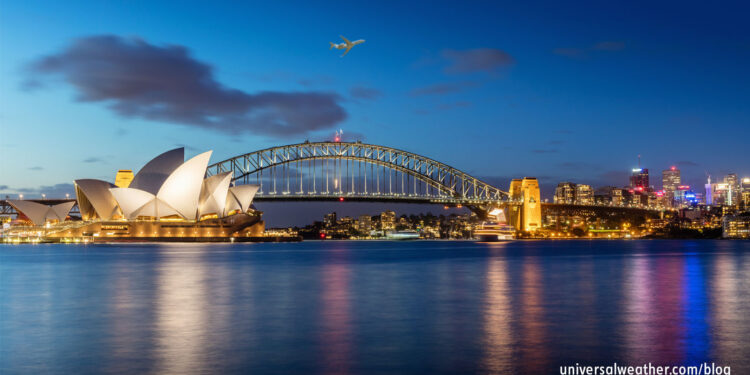Business Aircraft Ops to Australia: Part 2 – TSP, ADS-B, and Other Operating Considerations

This is a post by author Tony King. Tony is the managing director at Universal Aviation Australia. Tony is an expert on business aircraft operations in Australia and can be contacted at tonyking@universalaviation.aero.
This business aviation blog post continues from our article last week, entitled “Business Aircraft Ops to Australia: Part 1 – Top Airport Options.”
Australia has some unique operating requirements and considerations to be mindful of. Particularly for first-time business aviation charter (non-scheduled commercial) operators, it’s important to be aware of all documentation and procedural requirements and to be in full compliance.
The following is an overview of what you need to know:
1. Operating considerations
When you operate to Australia, there are landing permits, airport slots, curfew, and noise restrictions to be aware of. In addition charter operators must obtain Transportation Security Program (TSP) approval prior to operation to the southern continent.
2. Permit requirements
All General Aviation (GA) aircraft traveling to Australia require landing permits. Australia’s Civil Aviation Safety Authority reviews aircraft documentation, to ensure everything is correct, prior to issuing a permit. Charter operators, as well as certain high-frequency private non-revenue operators, will require TSP authorization. The purpose of a TSP is to demonstrate that an operator establishes and maintains a high level of security management in accordance with Australian regulations as well as international standards. The TSP program is administered by the Australian Office of Transport Security – specifically the Department of Infrastructure and Transport. While the application process can be rather lengthy, once a TSP is approved, it’s good for five years. For charter operators, it is best to apply for a TSP well in advance of any potential charter operation or on a just-in-case basis so that this requirement does not inhibit your travel arrangements to Australia.
3. Documentation
Upon arrival at your Australian Airport of Entry (AOE), a stamped GenDec, from your previous airport of departure, must be presented to airport authorities. This is a strict requirement for all international arrivals. Depending on the nationality of passengers and crew members, visas may be needed for Australia. As visas are not issued upon arrival, it’s important for operators to be aware of all applicable visa requirements. Online visas may be obtained for certain nationalities, while other nationals may need to obtain visas in advance from an Australian embassy.
4. ADS-B mandates
Pay close attention to ADS-B requirements when operating to Australia. If you’re not equipped and certified for ADS-B, Australian Air Traffic Control (ATC) may hold you down to FL290 or below. There are, however, certain areas of Australian airspace where exemptions are possible, to permit overflight without ADS-B. To secure an operating exception, you’ll need to submit specific information online in advance of your operations. For more information on Australian ADS-B requirements and mandates, see our article “Business Aviation ADS-B Mandates – Where Are We Now?” If you have any questions or concerns regarding ADS-B requirements, it’s suggested that you speak with a 3rd-party provider or local ground handler.
5. Disinfecting aircraft
For all international arrivals to Australia, operators are required to disinfect the cabins of their aircraft. This must be done with an approved insecticide, usually at top of descent. After the aircraft lands, the empty can of disinfectant must be turned in to airport quarantine officials. If this disinfection procedure is not completed on approach, it must be done on arrival, with all passengers/crew members in the cabin. Approved spray bottles of disinfectant may be purchased in Australia, in preparation for future trips. You may also purchase this product at certain international locations. Speak to your 3rd-party provider or ground handler for locations where these sprays can be sourced.
6. Preparing in advance
A week’s notice is recommended when planning a GA trip to Australia – particularly during the busy October through March period. If a major conference or sporting event is taking place at the particular destination, additional planning lead time is suggested. This is because aircraft parking, hotel accommodations, and preferred local transport options are typically in greater demand. Crew accommodations can be much more expensive during busy event periods, and fewer options may be available for shorter-notice trips.
7. Noise restrictions
In general all aircraft traveling to Australia must meet Stage 3 noise standards. There are exemptions available for government and/or air ambulance flights, but exemptions must be requested and approved well in advance of day of operation. Noise and curfew restrictions vary airport to airport in Australia. For example Adelaide (YPAD) has very particular restrictions in place concerning what makes and models of GA aircraft may operate during noise curfew hours.
Conclusion
When operating to Australia it’s suggested that operators check in advance to determine any airport slot, permit, curfew, CIQ availability, or applicable ADS-B requirements. While aircraft parking availability is not usually an issue in Australia, it can be at certain times.
Questions?
If you have any questions about this article or would like assistance planning your next trip to Australia, contact me at christinevamvakas@universalaviation.aero.




